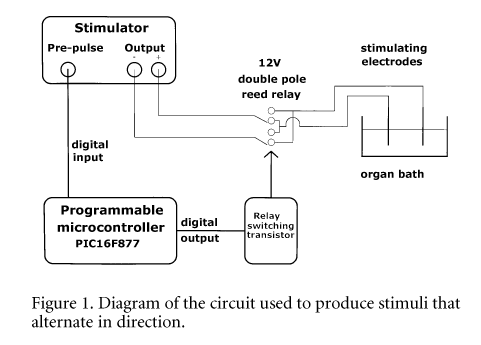When delivering electrical stimuli to muscle preparations, one electrode normally acts as the anode, one as the cathode. During chronic stimulation it may be advantageous to reverse the cathode and anode on alternate stimuli, to minimise the build-up of electrolysis products, and avoid electrode damage. Most commercially available stimulators do not have the facility to do this. We have, therefore, developed a simple circuit to reverse the polarity of the stimulating electrodes on alternate pulses.
Figure 1 shows the circuit diagram. The output of the stimulator is passed via a double pole change-over reed switch, to the bath electrodes. The position of the switch is controlled by a programmable microcontroller (PIC16F877, Microchip, USA). This device is programmed to respond to a pre-pulse from the stimulator by flipping the state of a digital output. Thus before each stimulus the pre-pulse from the stimulator triggers the microcontroller, which operates the reed switch, reversing the polarity of the electrodes.
For stimulators lacking a pre-pulse, it would be possible to trigger the microcontroller from the stimulus itself, programming it to delay the operation of the reed switch until a fixed period (e.g. 100 ms) after the stimulus.
This circuit provides a simple and cheap (< ú50 components) method of providing alternating stimuli from commonly available and economical commercial stimulators. The versatility and ease of programming of the PIC16F877 microcontroller enable it to be used for a wide range of applications. This will be demonstrated using a multi-purpose circuit board (EasyPic), which was developed in-house.
This work was supported by the British Heart Foundation and Wellcome Trust.

